#NIRCam
Explore tagged Tumblr posts
Text

A composite image of the Cosmic Cliffs in the Carina Nebula, created with the Webb telescope’s NIRCam and MIRI instruments. Pinkish brown clouds of gas and dust dominate the foreground of the image, glittering with young stars. Behind the glowing, mountainous clouds, the sky appears navy blue, with shining stars and galaxies.
36 notes
·
View notes
Text
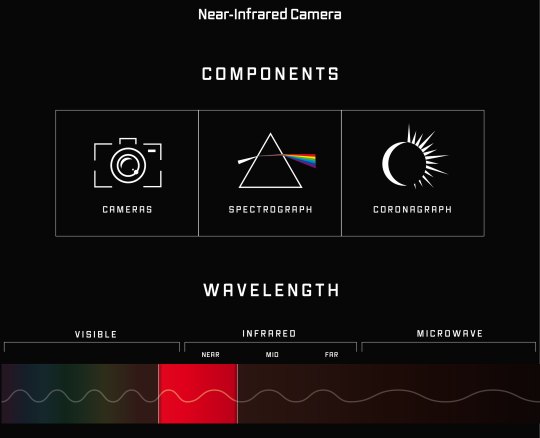
Many of the gorgeous space images that you see from the James Webb Space Telescope come from the Near-Infrared Camera (NIRCam). It provides high-resolution imaging and spectroscopy for a wide variety of scientific investigations. What can NIRCam “see” in space? https://webbtelescope.pub/4dEjG67
#space#astronomy#stsci#science#nasa#universe#nasawebb#james webb space telescope#webb#webb telescope#webb space telescope#nircam
33 notes
·
View notes
Text

Our chaotic Galactic Center !
A NIRCam near-infrared image of the Galactic Center, revealing a complex interplay of cosmic structures.
The image showcases a central region dominated by a bright, compact object, likely the supermassive black hole Sagittarius A*. Surrounding this core, a vibrant tapestry of filaments, bubbles, and stellar clusters unfolds.
Dark lanes of dust contrast with bright regions of star formation, creating a visually striking composition.
The image provides insights into the dynamic and energetic processes occurring within the heart of our galaxy.
Processed JWST/NIRCam data by Thomas Carpentier
#art#cosmos#cosmic#universe#blast#space#photography#stars#galactic#NIRCam#sagittarius A*#stellar#clusters#thomas carpentier#JWST/NIRCam
28 notes
·
View notes
Text

crab nebula by james webb (nircam, miri)
#crab nebula#nebula#james webb#james webb space telescope#space#space images#astronomy#miri#nircam#stem#cosmos
36 notes
·
View notes
Text

Jupiter captured by the James Webb Space Telescope:
The image, taken with Webb’s NIRCam, is a composite created from three filters — F360M (red), F212N (yellow-green), and F150W2 (cyan) — to account for the planet’s rapid rotation.
18 notes
·
View notes
Text
Tendrils of NGC 604
The James Webb Space Telescope’s NIRCam and MIRI capture the star-forming region NGC 604. What beautiful images!

NIRCam View
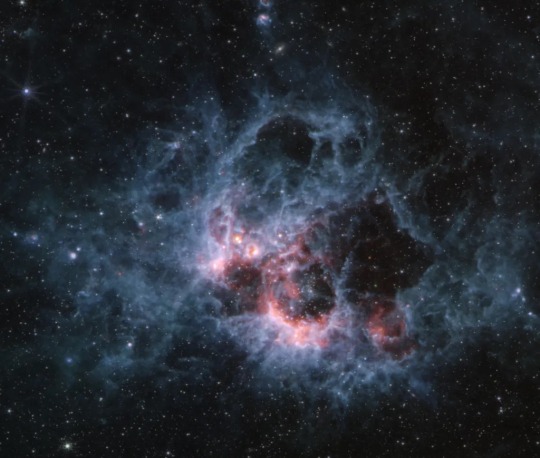
MIRI View
Full NASA article
v v v
#astronomy#nasa news#nasa#nasa photos#james webb space telescope#nircam#miri#ngc 604#space news#space#m33#galaxy#nebula#astronomy news#astrophotography
42 notes
·
View notes
Text

#IFTTT#Flickr#jwst#james#webb#space#telescope#nearinfrared#nircam#nasa#esa#galaxy#ngc#5068#star#dust#gas
16 notes
·
View notes
Text



ngc 6822
#jwst#james webb space telescope#ngc 6822#how tho#the universe is just crazy yo#irregular galaxy#barnards galaxy#sagittarius constellation#nircam#ic 4895
12 notes
·
View notes
Text

By Allie Yang
10 August 2023
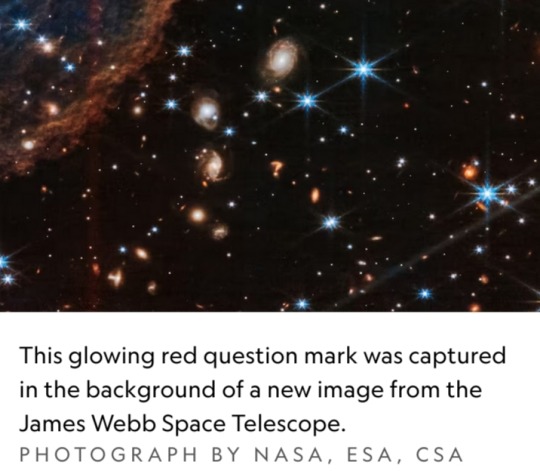
Two of our galaxy’s most famous stars were recently photobombed by what appears to be a celestial question mark.
The symbol was spotted in a new image from the James Webb Space Telescope (JWST) of the forming stars Herbig-Haro 46/47, which are well-known and have been frequently observed by astronomers.
These two stars can provide clues about how our own sun may have formed.
They’re relatively close to Earth, about 1,400 light-years, and relatively young, only a few thousand years old.
In fact, they’re still in gestation and have not technically been “born” yet, which is marked when the stars start shining from their own nuclear fusion.
The image is the first of the twin protostars from the NIRCam instrument on JWST.
It was captured using infrared light, which penetrates space dust more easily than visual light, and it is the highest resolution image of the objects ever seen at these wavelengths.
The telescope’s astonishing sensitivity allowed the glowing red question mark to be captured in the lower center of the image.
The object is far outside our galactic neighborhood, possibly billions of light-years away, says Christopher Britt, an education and outreach scientist at the Space Telescope Science Institute who helped plan these observations.
His best guess is that the question mark is actually two galaxies merging.
“That's something that's seen fairly frequently, and it happens to galaxies many times over the course of their lives,” he says.
“That includes our own galaxy, the Milky Way … [it] will merge with Andromeda in about four billion years or so.”
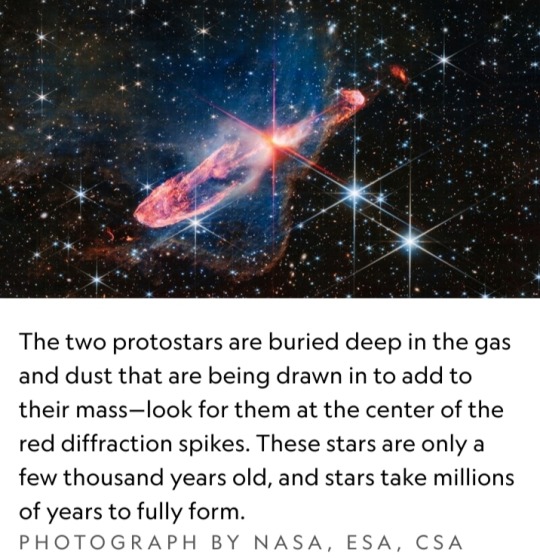
The hints pointing to two galaxies are found in the question mark’s strange shape.
There are two brighter spots, one in the curve and the other in the dot, which could be the galactic nuclei, or the centers of the galaxies, Britt says.
The curve of the question mark might be the “tails” being stripped off as the two galaxies spiral toward each other.
“It's very cute. It's a question mark … But you can find the colons and semicolons, and any other punctuation mark, because you have 10,000 little smudges of light in each image taken every half hour,” says David Helfand, an astronomer at Columbia University.
The sheer number of shining objects we find are bound to create some serendipitous images, and our brains have evolved to find those patterns, he says.
Astronomers have seen similar objects closer to home.
Two merging galaxies captured by the Hubble Space Telescope in 2008 also look like a question mark, just turned 90 degrees.
Helfand says the question mark seems to be two objects, the curve and the dot, but could be more that just happened to line up.
They could also be completely unrelated objects, he says, if one is much closer to Earth than the other.
Britt warns that estimating distance based only on colors in the image can be tricky.
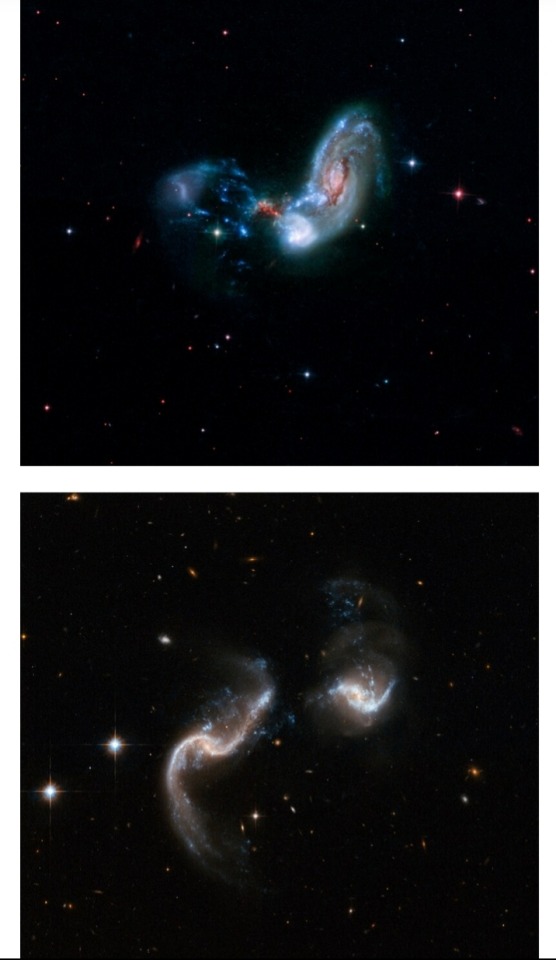
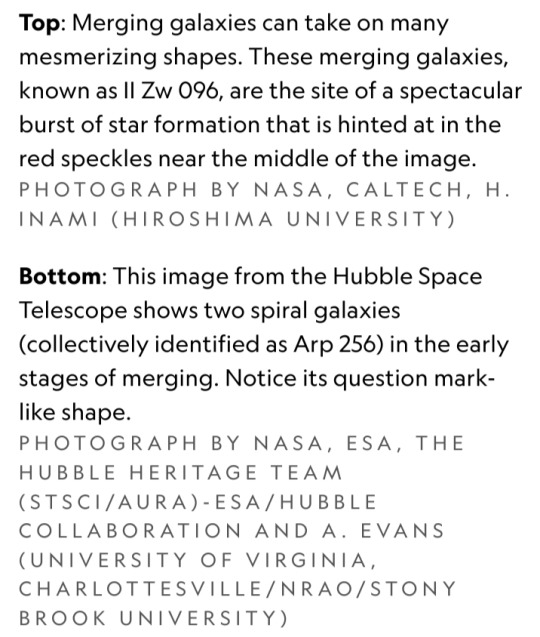
The red of the question mark could mean it’s very far away (light waves stretch as they travel through the expanding universe, shifting to redder wavelengths) or that it’s closer and obscured by dust near the object.
It would take more investigation to identify exactly how far away the question mark is.
This could be done by measuring photometric redshifts, determined by the brightness observed through different filters, but this would only provide an estimate for the distance, Britt says.
Spectroscopy, which analyzes light from the source to determine its elemental makeup, could provide a more exact distance but requires a separate instrument to measure.
Given the number of intriguing targets spotted by JWST, the question mark may never receive this treatment.
For now, the source of this symbol in the sky remains a cosmic mystery.
#James Webb Space Telescope (JWST)#celestial question mark#stars#galaxy#space#astronomy#Herbig-Haro 46/47#NIRCam#infrared light#protostars#Christopher Britt#Space Telescope Science Institute#galactic nuclei#astronomers#Hubble Space Telescope#photometric redshifts#Spectroscopy#cosmic mystery#National Geographic#Nat Geo#NASA
9 notes
·
View notes
Text
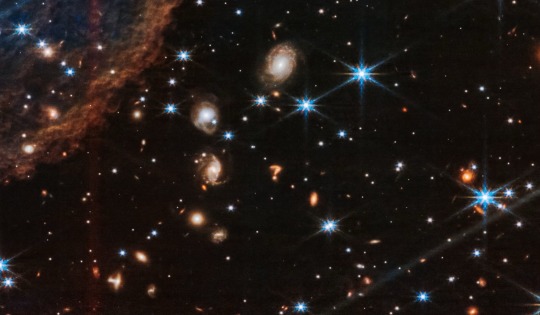
This glowing red question mark was captured in the background of a new image from the James Webb Space Telescope. Photograph By NASA, ESA, CSA
NASA Just Found a Question Mark in Space. What Exactly is It?
The object is far outside our galactic neighborhood, possibly billions of light-years away. But astronomers have seen similar objects closer to home.
— By Allie Yang | August 9, 2023
Two of our galaxy’s most famous stars were recently photobombed by what appears to be a celestial question mark.
The symbol was spotted in a new image from the James Webb Space Telescope (JWST) of the forming stars Herbig-Haro 46/47, which are well-known and have been frequently observed by astronomers. These two stars can provide clues about how our own sun may have formed. They’re relatively close to Earth, about 1,400 light-years, and relatively young, only a few thousand years old. In fact, they’re still in gestation and have not technically been “born” yet, which is marked when the stars start shining from their own nuclear fusion.
The image is the first of the twin protostars from the NIRCam instrument on JWST. It was captured using infrared light, which penetrates space dust more easily than visual light, and it is the highest resolution image of the objects ever seen at these wavelengths.
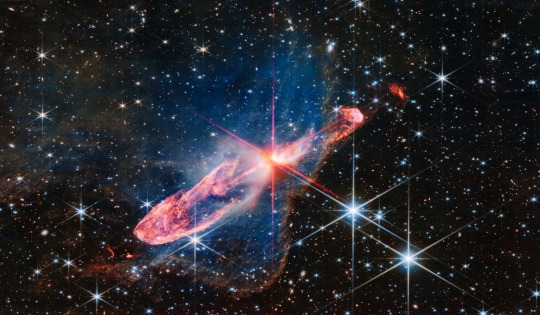
The two protostars are buried deep in the gas and dust that are being drawn in to add to their mass—look for them at the center of the red diffraction spikes. These stars are only a few thousand years old, and stars take millions of years to fully form. Photograph By NASA, ESA, CSA
The telescope’s astonishing sensitivity allowed the glowing red question mark to be captured in the lower center of the image. The object is far outside our galactic neighborhood, possibly billions of light-years away, says Christopher Britt, an education and outreach scientist at the Space Telescope Science Institute who helped plan these observations.
His best guess is that the question mark is actually two galaxies merging.
“That's something that's seen fairly frequently, and it happens to galaxies many times over the course of their lives,” he says. “That includes our own galaxy, the Milky Way … [it] will merge with Andromeda in about four billion years or so.”
The hints pointing to two galaxies are found in the question mark’s strange shape. There are two brighter spots, one in the curve and the other in the dot, which could be the galactic nuclei, or the centers of the galaxies, Britt says. The curve of the question mark might be the “tails” being stripped off as the two galaxies spiral toward each other.
“It's very cute. It's a question mark … But you can find the colons and semicolons, and any other punctuation mark, because you have 10,000 little smudges of light in each image taken every half hour,” says David Helfand, an astronomer at Columbia University. The sheer number of shining objects we find are bound to create some serendipitous images, and our brains have evolved to find those patterns, he says.
Astronomers have seen similar objects closer to home. Two merging galaxies captured by the Hubble Space Telescope in 2008 also look like a question mark, just turned 90 degrees.
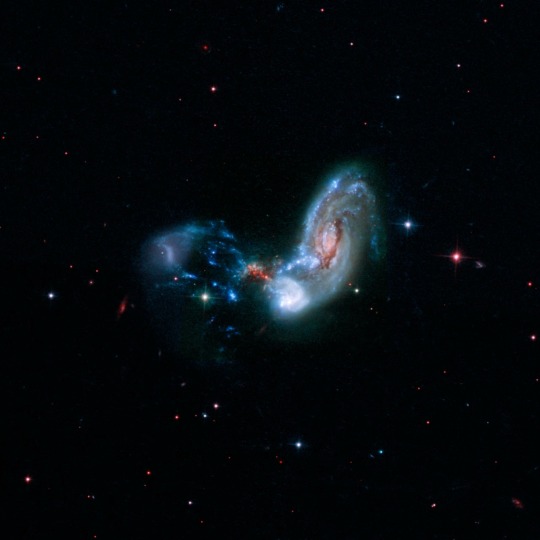
Merging galaxies can take on many mesmerizing shapes. These merging galaxies, known as II Zw 096, are the site of a spectacular burst of star formation that is hinted at in the red speckles near the middle of the image. Photograph By NASA, Caltech, H. Inami (Hiroshima University)

This image from the Hubble Space Telescope shows two spiral galaxies (Collectively Identified as Arp 256) in the early stages of merging. Notice its question mark-like shape. Photograph By NASA, ESA, The Hubble Heritage Team (STSCI/AURA)-ESA/Hubble Collaboration and A. Evans (University of Virginia, Charlottsville/NRAO/Stony Brook University)
Helfand says the question mark seems to be two objects, the curve and the dot, but could be more that just happened to line up. They could also be completely unrelated objects, he says, if one is much closer to Earth than the other.
Britt warns that estimating distance based only on colors in the image can be tricky. The red of the question mark could mean it’s very far away (light waves stretch as they travel through the expanding universe, shifting to redder wavelengths) or that it’s closer and obscured by dust near the object.
It would take more investigation to identify exactly how far away the question mark is. This could be done by measuring photometric redshifts, determined by the brightness observed through different filters, but this would only provide an estimate for the distance, Britt says. Spectroscopy, which analyzes light from the source to determine its elemental makeup, could provide a more exact distance but requires a separate instrument to measure.
Given the number of intriguing targets spotted by JWST, the question mark may never receive this treatment. For now the source of this symbol in the sky remains a cosmic mystery.
#NASA#Galactic#Billions of Light-Years#Galaxy 🌌#Allie Yang#James Webb Space Telescope (JWST)#NIRCam#NASA | ESA | CSA#Space Telescope Science Institute#Christopher Britt#Hubble Space Telescope#University of Virginia#Stony Brook University#Hiroshima University
3 notes
·
View notes
Text
Young Stars, Stellar Jets

High-speed outflows of molecular gas from a pair of actively forming young stars shine in infrared light, revealing themselves in this NIRcam image from the James Webb Space Telescope. Cataloged as HH (Herbig-Haro) 46/47, the young stars are lodged within a dark nebula that is largely opaque when viewed in visible light. The pair lie at the center of the prominent reddish diffraction spikes in the NIRcam image. Their energetic stellar jets extend for nearly a light-year, burrowing into the dark interstellar material. A tantalizing object to explore with Webb's infrared capabilities, this young star system is relatively nearby, located only some 1,140 light-years distant in the nautical constellation Vela.
NASA
#2023#your friendly neighborhood space nerd#jwst#jwst images#constellation vela#HH (Herbig-Haro) 46/47#NIRcam
2 notes
·
View notes
Text

Pandora's Cluster of Galaxies
2 notes
·
View notes
Text
Still less glowy than ma bestie's glow-up 💅✨
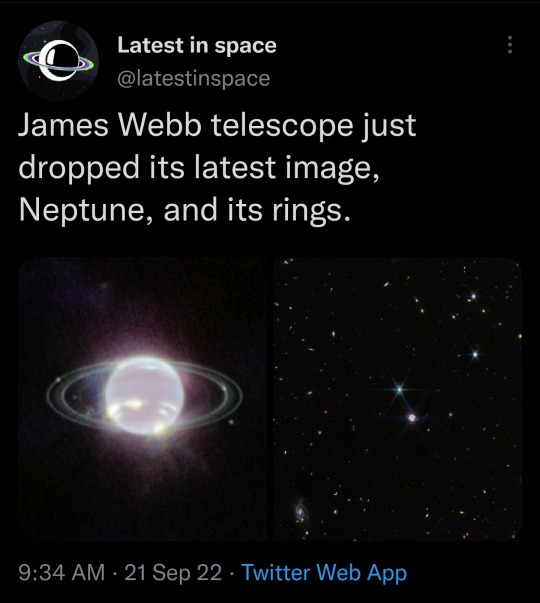
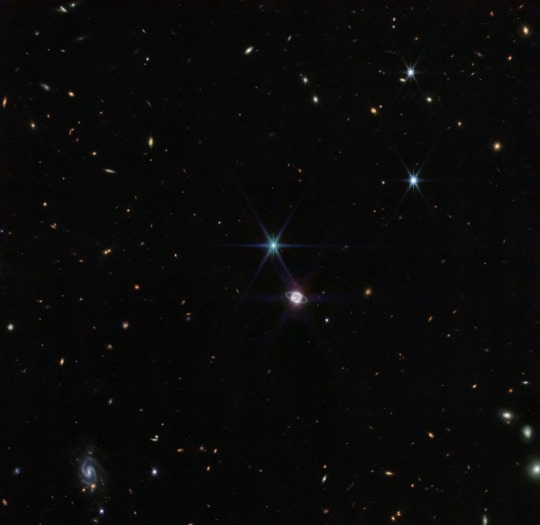

189K notes
·
View notes
Text
Webb’s Infrared Eye Reveals the Heart of the Milky Way
Evan Gough - Webb’s Infrared Eye Reveals the Heart of the Milky Way:
#jameswebb#spacetelescope#telescope#jwst#infrared#nircam#galacticcenter#milkyway#sagittariusc#infrareddarkcloud#idc#highvelocitycompactcloud#hvcc#supernovaremnant#snr#astrophysics#infraredastronomy#astronomy
0 notes
Photo

Çubuklu sarmal gökada NGC 5068'in James Webb Uzay Teleskobu'nun NIRCam aygıtından alınan bu görüntüsü, gökadanın parlak merkezi çubuğu boyunca en yoğun olan devasa yıldız popülasyonu ve içindeki genç yıldızlar tarafından aydınlatılan yanan kırmızı gaz bulutları ile süslenmiştir. Galaksinin bu yakın-kızılötesi görüntüsü, NGC 5068'in çekirdeğini oluşturan yaşlı yıldızların muazzam bir şekilde bir araya gelmesiyle doldurulmuştur. NIRCam'in keskin görüşü, astronomların galaksinin gazını ve tozunu dikkatle inceleyerek yıldızlarını yakından incelemesini sağlar. Yoğun ve parlak toz bulutları, sarmal kolların yolu boyunca uzanır: Bunlar, yeni yıldızların oluştuğu hidrojen gazı toplulukları olan H II bölgeleridir. Genç, enerjik yıldızlar etraflarındaki hidrojeni iyonlaştırarak kırmızıyla temsil edilen bu ışıltıyı yaratıyor.Kredi: ESA/Webb, NASA & CSA, J. Lee ve PHANGS-JWST Ekibi
#James Webb Uzay Teleskobu#NGC 5068#NIRCam#ESA/Webb#NASA & CSA#J. Lee ve PHANGS-JWST Ekibi#teşekkürler#H II
1 note
·
View note
Text
Horsehead Nebula (NIRCam image)

The NASA/ESA/CSA James Webb Space Telescope has captured the sharpest infrared images to date of one of the most distinctive objects in our skies, the Horsehead Nebula. These observations show a part of the iconic nebula in a whole new light, capturing its complexity with unprecedented spatial resolution.
Webb’s new images show part of the sky in the constellation Orion (The Hunter), in the western side of the Orion B molecular cloud. Rising from turbulent waves of dust and gas is the Horsehead Nebula, otherwise known as Barnard 33, which resides roughly 1300 light-years away.
The nebula formed from a collapsing interstellar cloud of material, and glows because it is illuminated by a nearby hot star. The gas clouds surrounding the Horsehead have already dissipated, but the jutting pillar is made of thick clumps of material that is harder to erode. Astronomers estimate that the Horsehead has about five million years left before it too disintegrates. Webb’s new view focuses on the illuminated edge of the top of the nebula’s distinctive dust and gas structure.
The Horsehead Nebula is a well-known photon-dominated region, or PDR. In such a region ultraviolet light from young, massive stars creates a mostly neutral, warm area of gas and dust between the fully ionised gas surrounding the massive stars and the clouds in which they are born. This ultraviolet radiation strongly influences the gas chemistry of these regions and acts as the most important source of heat.
These regions occur where interstellar gas is dense enough to remain neutral, but not dense enough to prevent the penetration of far-ultraviolet light from massive stars. The light emitted from such PDRs provides a unique tool to study the physical and chemical processes that drive the evolution of interstellar matter in our galaxy, and throughout the Universe from the early era of vigorous star formation to the present day.
Owing to its proximity and its nearly edge-on geometry, the Horsehead Nebula is an ideal target for astronomers to study the physical structures of PDRs and the evolution of the chemical characteristics of the gas and dust within their respective environments, and the transition regions between them. It is considered one of the best objects in the sky to study how radiation interacts with interstellar matter.
This image was captured with Webb’s NIRCam (Near-InfraRed Camera) instrument.
[Image description: At the bottom of the image a small portion of the Horsehead Nebula is seen close-in, as a curved wall of thick, smoky gas and dust. Above the nebula various distant stars and galaxies can be seen up to the top of the image. One star is very bright and large, with six long diffraction spikes that cross the image. The background fades from a dark red colour above the nebula to black.]
#Horsehead Nebula (NIRCam image)
#Credit:
#ESA/Webb, NASA, CSA, K. Misselt (University of Arizona) and A. Abergel (IAS/University Paris-Saclay, CNRS)
#Horsehead Nebula NIRCam image)#ESA/Webb NASA CSA K. Misselt (University of Arizona) and A. Abergel (IAS/University Paris-Saclay CNRS)
5 notes
·
View notes